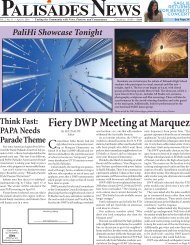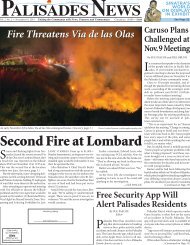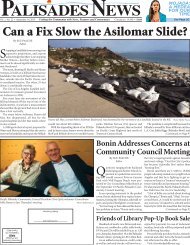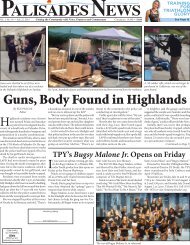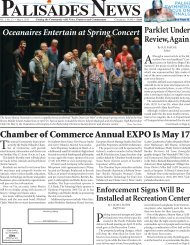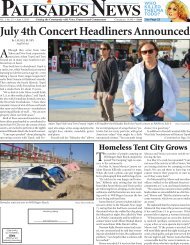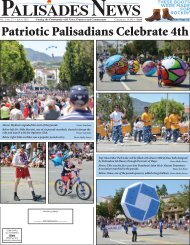Palisades-News-March-18-2015
Palisades-News-March-18-2015
Palisades-News-March-18-2015
Create successful ePaper yourself
Turn your PDF publications into a flip-book with our unique Google optimized e-Paper software.
<strong>Palisades</strong> <strong>News</strong><br />
<strong>March</strong> <strong>18</strong>, <strong>2015</strong> A forum for open discussion of community issues<br />
Page 7<br />
Daylight-Saving Time Rationale Questioned<br />
If someone told you a national policy would increase<br />
the risk of having a heart attack and getting into a<br />
traffic accident, would you blithely go along with<br />
it? Never question it?<br />
Welcome to Daylight-Saving Time. Repeated studies<br />
have shown that traffic accidents increase on the Monday<br />
following the start of DST, and the risk of having a heart<br />
attack increases in the first three days after switching to<br />
DST. Maybe California should join Arizona and Hawaii<br />
and leave the clocks alone.<br />
DST was called “fast time” when President Woodrow<br />
Wilson signed it into law in 19<strong>18</strong> to support the war effort.<br />
Writing for the History Channel (“8 Things You May<br />
Not Know about Daylight-Saving Time”), Christopher<br />
Klein points out, “In fact, the agriculture industry was<br />
deeply opposed to the time switch when it was first<br />
implemented. The sun, not the clock, dictated farmers’<br />
schedules, so daylight saving was very disruptive. Farmers<br />
had to wait an extra hour for dew to evaporate to harvest<br />
hay, hired hands worked less since they still left at the same<br />
time for dinner and cows weren’t ready to be milked an<br />
hour earlier. Agrarian interests led the fight for the 1919<br />
repeal of national daylight-saving time, which passed<br />
after Congress voted to override President Woodrow<br />
Wilson’s veto. Rather than rural interests, it has been<br />
urban entities such as retail outlets and recreational<br />
Hard Facts about<br />
Measles Vaccination<br />
Ryan Morelli’s letter [“Objections to Editorial and<br />
Cartoon about Measles”] in your <strong>March</strong> 4 edition<br />
suggests that the measles vaccine has caused more<br />
deaths than measles itself between 2004-<strong>2015</strong>.<br />
While I do not know Mr. Morelli’s background, I have<br />
been a pediatric RN since 1989 with an advanced degree<br />
in health service administration. I am currently a pediatric<br />
triage nurse at Cedars-Sinai. I feel I am qualified to<br />
comment on his letter.<br />
The writer quotes his facts from the VAERS database,<br />
which is co-sponsored by the CDC and the FDA. What<br />
he fails to cite is that VAERS clearly states that “no cause<br />
and effect relationship is established between vaccines<br />
and resulting deaths. The event (of severe adverse<br />
reaction/death) may be related to underlying disease or<br />
a condition, by concurrent meds or by chance.”<br />
According to data from the World Health Organization,<br />
15.6 million deaths from measles were prevented by the<br />
vaccination between 2000-2013. The National Vaccine<br />
Information Center, which uses data obtained from<br />
VAERS, states that since 1990 there have been 329<br />
deaths linked to the measles vaccine. Those statistics<br />
are overwhelmingly in favor of vaccination.<br />
There is no money to be made on vaccines for the<br />
physician. The only vested interest health professionals<br />
have in pushing vaccines is that they save lives and<br />
prevent debilitating complications.<br />
The reason there were no cases of measles in the U.S.<br />
between 2004 through the start of this year is because<br />
EDITORIAL<br />
businesses that have championed daylight saving over<br />
the decades.” Despite the repeal, some cities—including<br />
Pittsburgh, Boston, and New York—continued to use<br />
DST. During World War II, DST was called “War Time”<br />
and was implemented after the bombing of Pearl Harbor.<br />
After the war, states and localities were free to choose<br />
when and if they would observe DST. Time confusion<br />
led Congress to establish the Uniform Time Act of 1966,<br />
stating that DST would begin on the last Sunday of April<br />
and end on the last Sunday of October. States could pass<br />
a local ordinance to be exempt.<br />
The current DST schedule was introduced in 2007<br />
and follows the Energy Policy Act of 2005, starting on<br />
the second Sunday in <strong>March</strong> and ending on the first<br />
Sunday in November.<br />
How much energy does the country save by moving<br />
clocks an hour ahead in the spring and one hour back in<br />
the fall? In the 1970s, a U.S. Department of Transportation<br />
study concluded that total electricity savings associated<br />
with daylight saving time amounted to about one percent<br />
in the spring and fall months.<br />
By contrast, in the summer months, economists at<br />
UC Santa Barbara have calculated that Indiana’s move to<br />
statewide daylightsaving time in 2006 led to a one-percent<br />
rise in residential electricity use through additional<br />
LETTERS TO THE EDITOR<br />
measles was eradicated due to the vaccine.<br />
Guess what? It’s back and it is time to start protecting<br />
our babies, our children who cannot get the vaccine,<br />
and our immune-compromised friends and neighbors.<br />
There is no downside unless you have a medical reason<br />
to not get the vaccine. Please vaccinate. The alternative<br />
can be tragic.<br />
Sue Marguleas, RN, MPA<br />
Dog Also Attacked<br />
Thanks for the article, “Doggy Politics in the ‘Hood’”<br />
by Marci Slade Crestani, February <strong>18</strong>.<br />
My 12-pound dog has been attacked by large off-leash<br />
dogs three times. I asked a man to leash his dog this<br />
morning; he ignored me. I asked a man last week to<br />
leash two dogs; he ignored me. I now carry pepper<br />
spray whenever I walk my dog.<br />
Patty Detroit<br />
Cost for Technical Support For<br />
Incline Project Is Outlandish<br />
I thought I had become inured to the outlandish price<br />
tags on public projects, what with the surcharges for<br />
nepotism, graft, fraud, mismanagement and downright<br />
incompetence.<br />
Even I was shocked, however, to learn, from the<br />
cover story in the February 4 issue [“California Incline<br />
Update”] that Wallace, Roberts & Todd will be paid<br />
“almost $3 million” [according to Santa Monica City<br />
records] to provide 365 days of “technical support” to<br />
demand for air conditioning on summer evenings.<br />
Additionally, there are no current studies to document<br />
the increased demand for energy during evening hours<br />
for electronic devices such as cell phones and computers.<br />
There are no studies to document the effect on the<br />
increasing number of people who work split and<br />
evening shifts and the amount of energy savings, if any.<br />
The California Energy Commission did a report on the<br />
effects of Daylight-Saving Time on California electricity<br />
use in 2001. The study concluded that both winter<br />
daylight-saving time and the summer season double<br />
daylight-saving time would probably save marginal<br />
amounts of electricity.<br />
That same year, the California state legislature sent a<br />
Senate Joint Resolution to the White House and Congress<br />
asking to be allowed to extend DST year-round, but it<br />
was never acted on.<br />
A 2007 California report stated that DST effects had<br />
no statistically significant effect on total daily electricity<br />
use in the month of <strong>March</strong> 2007. And according to a 2013<br />
Rasmussen Report, only 37 percent of Americans see the<br />
purpose of DST, compared to 45 percent the year before.<br />
Maybe it’s time to re-examine a policy instituted<br />
during World War I that today has questionable energy<br />
conservation effects.<br />
the Incline project as “engineer of record.”<br />
Apparently, the time and expertise of this firm is worth<br />
$8,219 per day or $1,027 per hour for an eight-hour<br />
workday. Given that the median income, even among the<br />
affluent, highly-educated citizens of the <strong>Palisades</strong>, is less<br />
than $100 per hour, I am left to wonder how those elected<br />
to represent our interests sleep at night after approving<br />
such high expenditures of our hard-earned tax dollars.<br />
Lisa Wolf<br />
In Response to<br />
‘No Monday Breakfast’<br />
I read in the <strong>March</strong> 4 “Heard about Town” column<br />
that locals are bummed about the lack of places to eat<br />
breakfast. Please let Palisadians know that The Yogurt<br />
Shoppe on Swarthmore is open for breakfast.<br />
We offer 20+ different cereals (and yes, some healthy)<br />
along with regular and flavored yogurt, granola options,<br />
oatmeal, a wide variety of fresh fruits and choice of milk<br />
(oh, and we also offer shakes). Open daily for breakfast<br />
7 to 10 a.m. and 8 to 10 a.m. on Sunday.<br />
Kevin Sabin<br />
(Editor’s Note: Additionally, Tivoli owner Sohail<br />
Fatoorechi has started opening at 8 a.m. daily for people<br />
who need a meeting place for breakfast.)<br />
<strong>Palisades</strong> <strong>News</strong> welcomes all letters, which may<br />
be mailed to spascoe@palisadesnews.com. Please<br />
include a name, address and telephone number so<br />
we may reach you. Letters do not necessarily<br />
reflect the viewpoint of the <strong>Palisades</strong> <strong>News</strong>.




